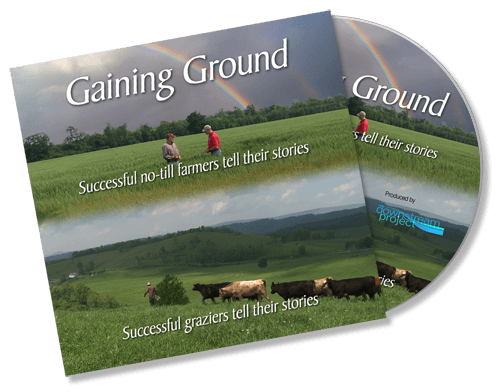Throughout history demonstrations have been a powerful tool used to initiate change in agricultural production practices. The farmer testimonials in the Gaining Ground movies are authentic and powerful but the demonstrations add another level of understanding to support the conservation message. Both the rainfall simulator and the root box demonstrations do not produce research level results, they are simply demonstrations that allow the viewer to see things that they normally do not see in the field.
Rainfall Simulator Demonstration
The rainfall simulator demonstration has evolved over the past several years. It started off with watering cans, soil runoff boxes, a ladder and runoff collection pails. The demonstrations can still be conducted using this type of effective, low cost procedure. Run-off Box Design Specs
Mr. Bud Davis professionally built the portable rainfall simulator shown in the Gaining Ground movies. This demonstration allows you to compare soil and water runoff from soils under very different management in an intense rainstorm event. For more information about a rainfall simulator contact Mr. Bud Davis by phone (785) 826-3215 or email gpdavis426@gmail.com .
Cropland Demonstrations
On cropland the rainfall simulator demonstration is primarily used to compare soils that have been managed in a long-term continuous tillage system versus a long-term no-till system. Other variations can be compared using cover crops and surface residue treatments. As seen in the movie, cropland soils managed in long-term no-till over time have less erosion and more infiltration during extreme rainfall events.
Grassland Demonstrations
On grasslands the rainfall simulator demonstration is primarily used to compare pasture soils that have been historically overstocked and overgrazed to pasture soils that have been managed following rotational stocking principles. As seen in the movie most pastures that are managed using rotational stocking over time usually develop a thick, dense pasture sod, that provides more plant canopy and organic residue on the surface that protects the soil. Thicker plant canopy and more surface residue alone helps decrease rainfall runoff and the risk of soil erosion while increasing the amount of rainfall that actually soaks into the pasture surface. Every additional drop of rainfall (a free resource) that can be harvested and stored in the soil, potentially increases forage growth and production the weeks following the storm event.
Pastureland Rainfall Simulator Fact Sheet
Root Box Demonstration Pastureland
The root box demonstration shown in the Gaining Ground Successful Graziers Tell Their Stories movie is used to show the effects of simulated grazing height and frequency on the root growth and persistence of tall fescue over time.
Both boxes were filled with potting media and planted to tall fescue in October 2009. The boxes were watered and kept in a greenhouse over the winter. By May 2010 the fescue had fully established and the root growth was visually equal and growing out the bottom of each 36” display.
The simulated grazing treatments began June 2010. One box with fescue was clipped to a level of 4 inches then allowed to grow again for approximately 30 days. This management continued throughout the 2010 growing season representing rotational stocking management. The other box with fescue was cut to a height of 2 inches and only allowed to grow for approximately 5-7 days then clipped back to 2 inches again. This management continued throughout the 2010 growing season simulating a continuous stocking system.

By October 2010 the simulated over grazing with continuous stocking management had drastically depleted the root system of the fescue while the simulated rotational stocking management still had a healthy, vigorous and expansive root system growing out the bottom of the display. The demonstration overwintered outside and was used many times throughout the 2011 growing season at pasture walks and similar outreach events.
This simple demonstration allows the viewer to see the impacts of different types of grazing management on root growth and persistence of forages.
This demo can be easily reproduced and used as a hands-on outreach tool to promote improved grazing management in your local area. Click on the file below for the Root Box Material and Construction Instructions and begin developing your demonstration today!
Root.Box.Fabrication.2009.09.11
Root Box Demonstration Cropland
The same type root boxes can be used to show relative root growth and development potential with cover crops. The primary use is to show root growth and development of cover crops planted at different times during the normal fall planting season. This emphasizes the importance of early plantings for maximizing root growth during the fall and early winter. They can also be used to plant different cover crop species to visualize how root growth and development varies by different species. The opportunities are endless. Get started planning your demonstration today!
Sharing Your Demonstration Experience
We would love to hear of your success using some variation of a root box demonstration in your local community. These are just a few ideas of how to use this demonstration tool. Let us know other ways you effectively use the root boxes as an outreach tool.
Whether your target audience is grassland farmers, cropland farmers, government officials and decision makers, or school students please contact us to share at least a brief email of your success.
Chris Lawrence J.B. Daniel
NRCS Cropland Agronomist NRCS Grassland Agronomist
(804) 287-1680 (434) 392-4171 x115
chris.lawrence@va.usda.gov
j.b.daniel@va.usda.gov





